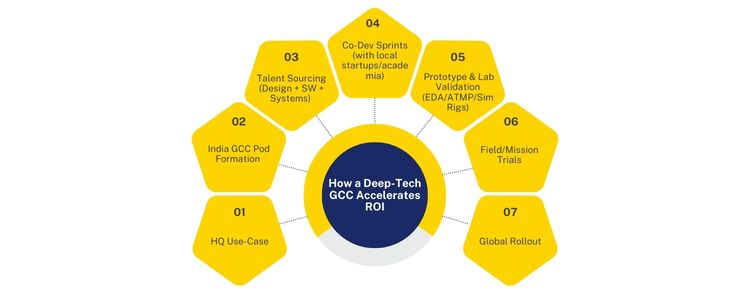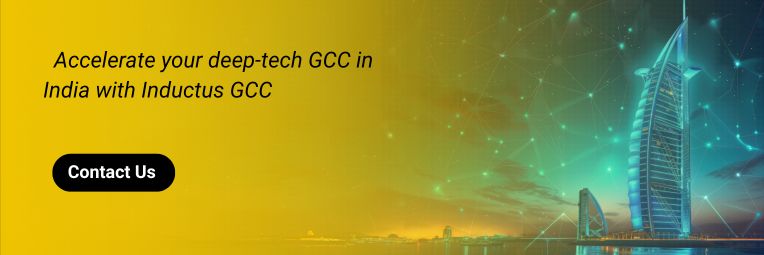
In 2025, an engineering center in Bengaluru saved weeks from AI-Axilator tape-out by co-designing firmware and verification in a single sprint, this is an example of how GCC support in Deep Tech which leads to global innovation command centers. There are now about 1900+ global capability centers in India, which provide employment to about 1.9 million professionals and generate revenue of more than US $46 billion-including increasing share in advanced engineering and research and development.
The speed is real. Government missions, mature talents and private investment are bringing quantum, chip and space tasks to Bangalore, Hyderabad, Noida, Chennai and Tier-2 in offshore capabiliity centers in cities.
Quantum Technology India: The National Quantum Mission (₹ 6,003.65 crore, 2023-2031) is the basis of national investment. In 2025, IBM and Andhra Pradesh announced the Amravati Quantum Center which would be part of a “Quantum Valley” and orders were issued to install the IBM system on the site. Algorithm Research, Error-mitigation, Hybrid Classical-Quantum Workflow, and Domain Use cases (Finance, Materials). The route of India prefer algorithm/application research-which the IBM leadership has described a differential factor for new winners-which makes India-based research and development centers are important.
Semiconductor: India’s ₹ 76,000 crore semiconductor incentives are being converted into implementation. Officials say about ₹ 65,000 crores are already committed by August 2025, 10 projects have been approved with a cumulative investment of US $ 18.23 billion. Front-end (Micro-Architecture, RTL), back-end (DFT, P&R), ATMP and reliability, as well as embedded software and driver. India already supplies about 20% of the world’s IC design workforce and prepares more than 800,000 engineers annually-India is a strong semiconductor talent Pool India for the GCC scale.
Space and Aerospace: India’s private space scenario has crossed 300 startups (between 2025), and firms such as Pixel and Dhruva Space have launched new satellites-a composed payload and ground-system pipeline for GCC. Mission assurance, avionics software, communication and ground segment, satellite bus and digital twin for propulsion analysis, often in collaboration with ISRO and a dense startup series.
Quantum: Priority to GCC used in material search, risk analysis and logistics optimization; To obtain quick hardware access and ecosystem partnership, keep pace with NQM centers and the Amravati Quantum Valley scheme. Semiconductor: Install anchor centers near emerging fabs/ATMP clusters and EDA vendor ecosystems; Take advantage of national incentives and ten sanctioned projects to keep design, verification and package engineering teams together. Space: Create mission software, ground systems and payload analytics GCC; Fastly growing private launch for real flight heritage and take advantage of EO pipeline (eg, pixels/pole).
By 2030, the GCC satellite teams will be transferred to the program lead for quantum algorithms, chiplet architecture and space-mission software, which will be run by India’s policy compatibility and talent density. Expect more strictness in transfer of headquarters in India, more offshore capability centers and national missions related to national missions in Tier-2 cities.
India’s global capabiliity centers in India are now strategic engines for quantum technology, semiconductor design and space systems, which are supported by solid policies, approval and launch in 2025. If you are planning to build an intensive technology, then the question is no longer in India, but where and how fast it is.
Inductus GCC helps in establish or expand your intensive technology with proven strategies. The inductus helps you choose the right city, encouragement, partner and talent model to get the right results at first itself..
A GDC refers to a single-minded offshore deployment, which provides proficient business, technology and operational services to corporate bodies on a global basis. BFSI, IT services, healthcare, telecom, retail, manufacturing, and other upcoming technologies, including AI and blockchain. They do not only target cost savings but now aim at innovation, automation, R&D, digital transformation, and high-value consulting. They design and create cloud, artificial intelligence, analytics, cloud security, and process automation. A large supply of STEM graduates, multilingual workers and niche skills in AI, ML, cloud, and analytics. Aditi, with a strong background in forensic science and biotechnology, brings an innovative scientific perspective to her work. Her expertise spans research, analytics, and strategic advisory in consulting and GCC environments. She has published numerous research papers and articles. A versatile writer in both technical and creative domains, Aditi excels at translating complex subjects into compelling insights. Which she aligns seamlessly with consulting, advisory domain, and GCC operations. Her ability to bridge science, business, and storytelling positions her as a strategic thinker who can drive data-informed decision-making.
India's Deep-Tech GCC Scenario
Quantum Computing
Semiconductor
Space Research and Development
Strategic & Economic Advantages of India
Advantage
What it means for GCCs in Deep Tech
Depth of talent
Large STEM pipeline; ~1.9M+ GCC workforce; design-ready IC talent base.
Policy & incentives
NQM and Semiconductor Mission de-risk early R&D and capex; fast approvals.
Ecosystem density
300+ space startups; global OEM/R&D centers (Airbus, Boeing, TI, Qualcomm, Intel) to partner with.
Speed-to-outcome
Mature design-services vendors + GCCs enable parallelization (design, firmware, test) reducing cycle times (illustrated by 2025 tape-out wins). (Inference based on ecosystem maturity and recent approvals.)
Economic leverage
Cost-efficient R&D versus Western hubs; scale benefits from India’s installed GCC base >1,700 and revenue >US$46B.
Intensive Analysis of Sector

Future Outlook
Conclusion
frequently asked questions (FAQs)

Aditi
Hey, like this? Why not share it with a buddy?
Related Posts
Recent Blog / Post
- Why Mid-Sized Companies are Embracing the GCC Model October 16, 2025
- What Is A Global Capability Center (GCC), and Why Is It Essential For Modern Business? October 16, 2025
- Gurugram’s Tech Ascent: Decoding the New Haryana GCC Policy October 15, 2025
- Scaling Your Tech Team: A Beginner’s Look at the Offshore Development Center October 15, 2025
- Agile Methodologies for GCCs: A Blueprint for Success October 6, 2025
- The Legal and Compliance Checklist for a New GCC Setup October 4, 2025
- The Rise of Niche GCCs: A Focus on Specialised Capabilities October 4, 2025
- The Impact of Regulatory Changes on GCC Operations October 4, 2025
- Cybersecurity for GCCs: A Proactive Approach to Data Protection September 30, 2025
- Beyond Cost: Measuring the True ROI of Your GCC Investment September 29, 2025
- The Future of GCCs in the Retail Sector: A Strategic Playbook September 29, 2025
- David vs Goliath: Mid-Sized GCCs Quietly Outperform the Big Brands September 29, 2025
- Infineon’s Big Bet on India: Inside Its First GCC in GIFT City September 29, 2025
- From Campuses to Capability Centres: How Indian Universities Power the Global GCC Ecosystem September 29, 2025
- Retail Meets Digital: Costco’s GCC in Hyderabad Marks a Global Shift September 29, 2025
















